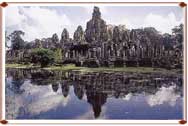Preservation and restoration of the Bayon temple
©UNESCO 2003
"In historical and architectural terms, the Bayon temple (late 12th century) in the centre of the last city of Angkor Thom is one of the most important monuments within Angkor Park. Unfortunately, it is now in a critical condition. The project aimed to restore the Northern Library, which is in danger of collapse, and to draw up a Masterplan for the preservation of the whole Bayon complex.
Restoration of the Northern Library was completed in September 1999. The dismantling of its foundations in 1996 revealed that their irregular subsidence had been due to the soil beneath breaking up over time. The JSA compacted the sand layer to harden the soil with a traditional compacting tool called an "Elephant's Foot", adding slaked lime to achieve higher density.
The original stones were used, broken ones being re-used after repair with an adhesive agent.
Data collected as a result of the scientific analysis of the causes of deterioration conducted during the dismantling and reconstruction process have been made public, and they will serve as the basis for drawing up a Masterplan for the monument. This will include a risk map, essential for the future safeguarding of this exceptional monument.
A ceremony was organized under the patronage of Her Majesty Queen Norodom Monineath, and this marked the completion of restoration activities at the Northern Library.
In order to develop the most suitable methods of preservation and restoration that would respect as far as possible the original structures of the monuments, and a Masterplan for the safeguarding of Bayon under optimum conditions, the JSA began to organize annual symposium on Bayon in 1996, the most recent of which was held in Siem Reap on 9 and 10 December 2002. During these scientific meetings, attended by representatives of the Cambodian authorities and interna-tional experts, many technical and ethical issues regarding the safeguarding of Bayon and the Angkor monuments were discussed."
(Extract from "Preservation of Tangible Cultural Heritage through the UNESCO/Japanese Funds-in-Trust" p.7)
Angkor is inscribed on the World Heritage List.
Latest Publication on the International Cooperation through the UNESCO/Japanese Funds-in-Trust (
pdf, 2.91MB)
Second publication (2003) concerning the Japanese Funds-in-Trust Preservation of Cultural Heritage (
pdf, 2.29MB)
First publication concerning the Japanese Funds-in-Trust Preservation of Cultural Heritage (1998) (
pdf, 5.92MB)
Back to : The Japanese Funds-in-trust for the Preservation of World Cultural Heritage
Legal Matters | About Accessibility | Privacy Policy
Copyright : 2013 Permanent Delegation of Japan to UNESCO
